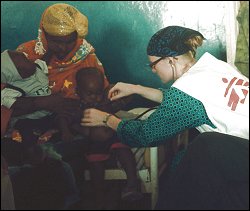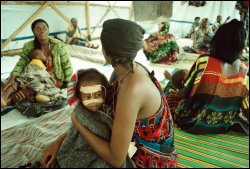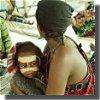"We had patients coming to us from 500 miles away"
Fourteen years of violence have dramatically affected Somalia's population of nine million, with approximately two million people displaced or killed since civil war erupted in 1990 and close to five million people estimated to be without access to clean water or health care. The collapse of the health-care system, along with most other state services, have hit women and children particularly hard: one in sixteen women dies during childbirth; one in seven children dies before their first birthday; and one in five children dies before the age of five. Even though a recently selected central government offers a glimmer of hope, violence still shatters people's lives. The continuing insecurity in many areas and a lack of international attention has resulted in a dearth of meaningful emergency assistance, leaving many desperate segments of society abandoned and all but forgotten. The following is an interview with Colin McIlreavy, Doctors Without Borders/Médecins Sans Frontières (MSF) head of mission in Somalia for the past year. McIlreavy has worked with MSF in other conflict zones, including Burundi and the Democratic Republic of Congo.
| "If you're going to work in Somalia you've got to be very realistic. You're going to encounter a great deal of problems. At a moment's notice you may have to withdraw all your staff and close your project down." –Colin McIlreavy, MSF head of mission in Somalia |
Can you describe the situation in Somalia?

A doctor from MSF at work in a hospital in Galcayo, Somalia. Photo © Petterik Wiggers |
You can probably say the past couple of years have been more stable than what it was during the early 1990s, but there are still intense period of violence. In 2003, we treated 961 victims of violent trauma, mostly gunshot injuries in our hospital in Galcayo, while in 2004 we treated more than 700, and this is one of the more stable parts of the country. Children under five years of age accounted for approximately 10 percent of these cases. Levels of violence in other parts of the country, particularly the capital Mogadishu, are much more extreme.
Some people have been able to develop stronger coping mechanism to deal with the lack of health care and periods of hunger, and for a small percentage of the population they have developed some businesses particularly in telecommunications, in money transfers, in the import and export of livestock and other goods. But this is very small proportion of the population. There are minority ethnic groups that have historically been excluded from positions of power, good access to land, ownership rights, or even a voice in local decisions. This would include the Bantu group, who inhabit the lower Shebelle and lower Juba valley, one of the areas where MSF is working. Some of those families are living in very difficult circumstances.
In Galcayo and indeed around many of the bigger towns such as Mogadishu and Kismayo, there are tens of thousands of people that are living as internally displaced people and many of them are living in the shells of destroyed houses or in very crude shelters made out of plastic sheeting and old clothes stitched together. These groups are more vulnerable to epidemic diseases such as cholera or meningitis as well as malnutrition. At the end of 2004, MSF responded to a spike in malnutrition. Many nomadic herders had lost camels and goats, their livelihoods, to a protracted drought throughout much of northeast Somalia. We saw admissions to MSF's therapeutic feeding center (TFC) for severely malnourished children increase dramatically to 184 in December 2004. Admissions had typically averaged 40 per month throughout most of the year.
Many of these pockets of extremely vulnerable groups are just living from year to year and struggling through without any contact with aid organizations. Often, no one knows the severity of their situation.
Can you give an example of how desperate people are for assistance?
Last November, with the World Food Program, we began distributing 250 pounds of food per family to families requiring nutritional assistance in our TFC in Galcayo. We had patients coming to us from 500 miles away. We found that they were coming from all directions–north, south, east and west, particularly west, from Ethiopia. Galcayo is about 100 kilometers from the border of Ethiopia and we were finding that 40 percent of our admissions were from Ethiopia because on that side of the Ethiopian border there's no similar feeding center.

A mother and child in the MSF theraputic feeding center in Galcayo, Somalia. Photo © Petterik Wiggers |
Many of the children never make it to our feeding centers. We conducted a retrospective mortality study in the Lower Juba area in the three-month period until November 2004. The results were shocking. It is estimated that mortality rates for children under five reached 16.83 deaths per 10,000 people per day. In other words, more than 15 percent of the young children died within this short time span. These are catastrophic disaster levels that speak to the tremendous needs in this country and would provoke a response from the aid community in most other countries.
What is the reality of providing aid in Somalia?
I'm not going to pretend that Somalia is anything other than one of the most violent places for aid organizations to work. It has had very high levels of violence, including very high levels affecting aid organizations for the past 10 or 15 years. And aid organizations have understandably become extremely cautious about trying to work there. [It is the only country in which MSF works where all foreigners - be they journalists, businessmen, or aid workers - require armed protection as a matter of fact. Foreigners are particularly exposed to violence because they are not covered by the Somali clan-based "law and order" mechanisms that have replaced police and courts in the wake of the central government's collapse.]
Having said that, I would still feel that the approach of many aid organizations, donor governments, towards provision of humanitarian aid in Somalia is very limited. When you compare what is going on in other contexts, Somalia is very violent, but I have also worked in the Democratic Republic of Congo (DRC) and in Burundi. When I worked in these countries the level of violence was not that different from what we see in many parts of Somalia. The aid community does not bring the same willingness to engage in Somalia as it does to the DRC, Burundi, and Sudan, even though security in these countries can be potentially as risky as in Somalia, and the level of need for health care, sanitation, and nutrition in Somalia are at least as great.
If you're going to work in Somalia you've got to be very realistic. You're going to encounter a great deal of problems. At a moment's notice you may have to withdraw all your staff and close your project down. So planning and implementing a project can be very difficult and you must anticipate a lot of change. And that's a little bit difficult for many organizations. Aid organizations cannot measure their work in Somalia by the normal standards–number of children vaccinated, latrines dug, or surgical operations performed in a month. In Somalia you have to continually try to reach as many as people as you can, and that is subject to constant change.
Do the needs outweigh the risks? That is a calculation that I think you have to do on a very regular basis for Somalia. Over the past 12 months, there were many days when we said, "no, the needs don't outweigh the current risks," and then we have evacuated the team, which happened maybe 10 times over the past year. You have to understand that that's part of working in this environment. The security situation in Somalia is very unpredictable – we take the step to evacuate teams when we see clear threat to us, or where we experience tensions rising to level that may not directly affect us or be targeting us but where we feel it unwise to be in a situation where people may react violently. We'll also evacuate as a precaution, when situation gets to a point where we feel uncertain what may happen and when we are simply scared.
You have evacuated the MSF teams on numerous occasions in the past year. How is providing aid in Somalia different than other conflict zones?
Within the four walls of the feeding center that we have in Galcayo or in Marare it's no different from a feeding center that you would find in the DRC, Burundi, Sierra Leone, or any other county where MSF is working. The bulk of our work is medical. But as well as having our staff putting a lot of energy into practical medical work, we also have to put a lot of time and effort into trying to understand and explain ourselves within a chaotic environment. There is no formal government or even informal government in Somalia. The clan elders are the closest thing to local government in Somalia. They are the leaders of their community, the leaders of their clan, but some of that leadership structure is very volatile in itself and some of them are terribly strong. There's a lot of diverse groups, a lot of local village elders that will claim some involvement or will refuse other elders to speak on their behalf.
So to work in this context requires the project coordinators on the ground and the country management team to ensure that we're understanding the different power elements in the area and explaining to these power elements why we're there and how we wish to work. We are constantly reinforcing that MSF works in an impartial way, outside the political struggle, and solely focuses on delivering practical medical assistance. But there's a huge amount of work that goes into maintaining the understanding of MSF's priorities and our acceptance within this very violent context.
In the capital itself, there are several green lines, which delineate the different zones of the city, which are controlled by rival militia groups. This makes movement within different parts of a single city potentially dangerous. For example crossing the 'green line,' which divides north and south Galcayo in territory held by militia from the Darood and Saad clans respectively, MSF aid workers travel in a neutral car – that is a car owned and driven by a member of a neutral clan. This car is accompanied by an armed escort traveling with militia from one side. The escort car stops 100 meters or so short of the 'green line' and the car transporting the MSF staff members proceeds, picking up the escort of the opposing militia approximately 100 meters on the other side of the 'line.' It's a bit scary, yet it works!
With all the evacuations, how does MSF provide ongoing care?
There's very few trained medical staff in Somalia as a whole and there's hardly any in the southern part of the country where it's been very violent and people that had training or a valuable skill have either moved to more stable parts of the country or left just because they've got a valuable skill that they use in safer job elsewhere. So we had to train a lot of staff literally from scratch and find people that are able to read and write and to develop those into national staff capable of performing most of the functions of a clinic in our absence.
But evacuations do impair the quality of care, which goes on during the forced absence of the expatriate staff because it puts a lot of strain on our national staff and we don't have any Somali doctors among our national staff. So evacuations do damage the quality of care but fortunately the national staff has been able to struggle on through and provide quite good care during our absence.
What type of aid is needed in Somalia?
Somalia has so little in the way of provision of health services that the list of acute health needs is very long. Malnutrition is certainly a big problem. I think there may be some spikes in the Galcayo area of malnutrition, but I would probably feel that the malnutrition issue in that area is more chronic. While we have large numbers of admissions, possibly the bigger issue for us in Galcayo is reaching more of the malnourished patients and making it possible for them to come and access our therapeutic feeding centers.
In Marare, we fear malnutrition peaks twice a year, which corresponds to the hunger gap, the period before the people in the area make their harvest. So many of them in the area have had a succession of poor harvests, so after the harvest they usually have some quantity of food harvested, but that gets depleted and maybe exhausted before the next harvest comes in, so that creates a hunger gap. So probably our next hunger gap is going to come around June and July. We will anticipate an increase of malnutrition in Marare.
The rainy seasons usually start in March and runs through May. The rains aren't as heavy in Somalia as in other countries, but it does often lead to outbreaks of cholera in some of the larger cities. So that would be an issue that we have to watch. And there are other acute health emergencies that we've been involved with that are truly unpredictable like the upsurge in trauma cases coming to our hospital in Galcayo.




